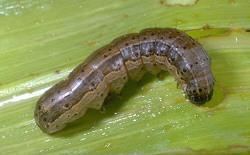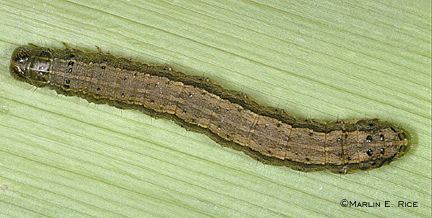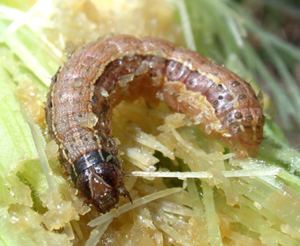Kingdom Animalia Order Lepidoptera Genus Spodoptera Rank Species | Phylum Arthropoda Family Noctuidae Scientific name Spodoptera frugiperda Higher classification Spodoptera | |
 | ||
Similar Spodoptera, Insect, Noctuidae, Butterflies and moths, Helicoverpa zea | ||
How to use a sweep net to find fall armyworms
The fall armyworm (Spodoptera frugiperda) is part of the order of Lepidoptera and is the larval (see caterpillar) life stage of a fall armyworm moth. It is regarded as a pest and can wreak havoc with crops if left to multiply. Its name is derived from its feeding habits. Native to Americas, these caterpillars mainly attack maize crops. They will eat everything in an area, and once the food supply is exhausted, the entire "army" will move to the next available food source.
Contents
- How to use a sweep net to find fall armyworms
- Description
- Habitats
- Feeding habits
- Infestations
- Research use
- References

Description

The larvae are a dull yellow to gray with stripes running down the length of the body. The mature caterpillar is about 1.5 to 2 inches (51 mm) in length. Fall armyworm's life cycle is completed within 30 days during summer and 60 days during spring and autumn seasons. During the winter seasons these caterpillars' life cycle lasts about 80 to 90 days. Armyworm's egg is dome shaped, and measures around 0.4 mm in diameter and 0.3 m in height.

It is active a different time than the true army worm, outbreaks of which usually occur during the early part of the summer; the fall army worm does most damage in the late summer in the southern part of the US, and early fall in the northern regions.
Habitats

The fall armyworm is widely distributed in eastern and central North America and in South America; it cannot survive freezing temperatures.
Feeding habits

The armyworm's diet consists mainly of grasses and small-grain crops. An infestation is hard to detect, as the caterpillars migrate to new feeding areas in the cool of the night. When the caterpillars near maturity, they can lay waste to an entire crop in a few days.
Infestations
In 1998, Illinois was hit hard by fall armyworms.

In early 2017, armyworms infested large swathes of corn crops across Southern Africa, devastating the livelihood of many farmers. It is thought they arrived from the Americas as armyworm eggs in imported produce. Many African countries have agreed to take urgent actions against armyworms.
Research use
S. frugiperda cells (Sf9 and Sf21 cell lines) are commonly used in biomedical research for the purpose of recombinant protein expression using insect-specific viruses called baculoviruses.
